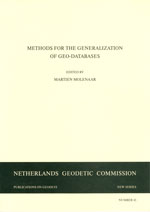
Martien Molenaar (eds.)
Publications on Geodesy 43, Delft, 1996. 78 pagina's.
ISBN-13: 978 90 6132 258 0. ISBN-10: 90 6132 258 8.
Foreword
Multi-scale approaches form at present one of the focal points of the GIS research community. This is due to the rising awareness that many processes on the earth surface can only be monitored and managed if they are understood in their geographical context. Part of this context is defined by the scale range at which these processes work. If we consider for instance the development of land use in a district, then we see that this is driven by actors at a lower aggregation level such as farmers, residents and companies. Their activities are constrained however by the socio-economic conditions and the infrastructure at regional level and by the macro economic planning at national and supra national level. An other example is the development of the natural vegetation cover of certain regions. The actual state of such a vegetation cover is defined by the co-occurrence of species that form vegetation types, which are part of eco-systems. Their development will be constrained by climatic conditions, the geologic and soil condition of the region and its hydrology. Here too we find hierarchical levels of organization.
The monitoring and management of such processes requires information at different scale levels. The research problem for the GIS community in this context is:
- to decide for each type of process which information should be handled at each scale level,
- to develop methods for transferring information between the different scale levels so that duplication of expensive data acquisition can be avoided as much as possible, and so that the consistency between data at the different scale levels can be maintained.
This second item is strongly related to the long standing research problem of map generalization, that is why it is often seen from that perspective. Researchers in this field become more and more aware of the fact, however, that multi-scale approaches in a GIS environment can be dealt with by data base generalization operations. These allow approaches that are quite different form the procedures applied in map generalization and they are more flexible.
This new research field derives it terminology and many of its concepts from both cartography and the object oriented approaches of computer science. This mixture of the idiom of different disciplines leads often to confusion so that the concepts that are covered by the terminology become fuzzy. This confusion may send researchers in the wrong direction when they want to solve multi-scale problems. The subcommission on GIS of the Netherlands Geodetic Commission organized a workshop on the 7th December 1995 to discuss these problems. Five authors were invited to present papers in which generalization problems were treated from several perspectives:
- Ferjan Ormeling presented the cartographic perspective, where the visualization of spatial data at different scale levels plays a central role,
- Martien Molenaar presented a data base perspective for generalization, emphasising the role of topologic and semantic (hierarchical) data models,
- Peter van Oosterom et. al. explained how multi-scale storage of spatial data could be organised by means of three hierarchical datastructures,
- Arnold Bregt et. al. used the example of a soils database to explain three spatial aggregation strategies and their effect on the quality of the derived databases,
- Arthur van Beurden discussed the difference between the processing of aggregated data and the aggregation of processed data, the production of maps for environmental data served as an example.
These papers form the contents of this bundle. We hope that the different approaches they present will help the reader to understand the different concepts that play a role in the generalization of spatial data and that the different strategies that are presented are of use for solving multi-scale problems.
The organizers of the workshop would like to thank the Netherlands Geodetic Commission for the financial support for the workshop and for the publication of these proceedings. Special thanks are due to Frans Schröder, secretary of this commission, who was responsible for a major part of the preparations of the workshop and for this publication.
Martien Molenaar
Chairman of NCG subcommission on GIS
Contents
- Foreword v
- Ferjan Ormeling
- Aggregation objectives and related decision functions 1
- Martien Molenaar
- The role of topologic and hierarchical spatial object models in database generalization 13
- Peter van Oosterom and Vincent Schenkelaars
Applying reactive data structures in an interactive multi-scale GIS 37 - Arnold Bregt and Jandirk Bulens
Application-oriented generalization of area objects 57 - Arthur van Beurden
Applying aggregations in policy support research at RIVM 65